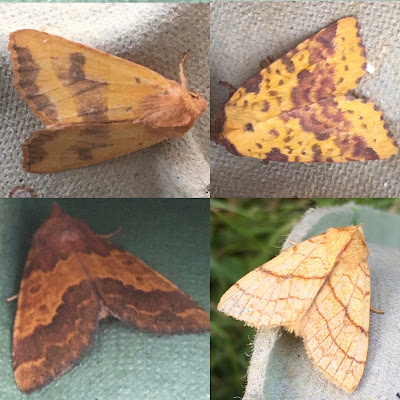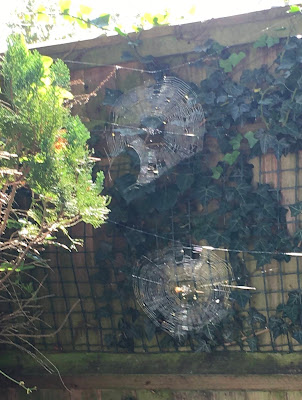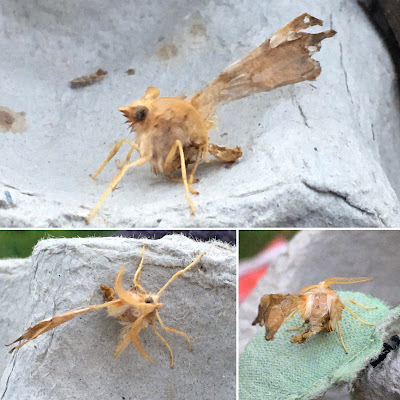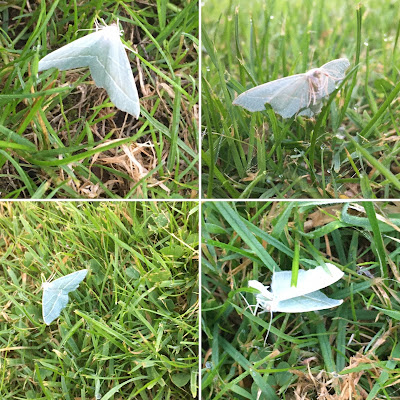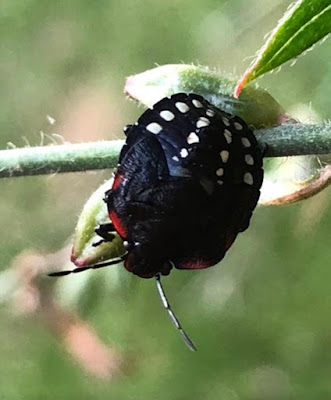
Wednesday 30 September 2020
Wearing of the Green

Sunday 27 September 2020
De bonne heure
I had a lucky break this morning after I thought that I'd have to satisfy myself with a brief discourse on the different colourways of that currently populous moth, the Lunar Underwing. I photographed a light grey one and a brown one and was about to add a dark grey example when the battery on my iPhone ran out.
The moth was starting to whirr its wings, so rather than risk taking it into the warmth of indoors while I plugged the 'phone in to the recharger, I took it to the house wall where I hoped that it might settle on a similarly grey background. As I tried to persuade it off my finger, my eye caught a different and much more attractive colour nearby. Just above and to the right of a snoozing Black Rustic, whose unmissable triangle I had spotted earlier but had not intended to investigate (they are as common as the Lunar Underwings just now) was the year's first Merveille du Jour.
My previous dates for the year's first Marvel are: 2013: 16 Oct, 2014: 9 Oct; 2015: 10 Oct; 2016: 9 Oct, 2017: 9 Oct; 2018: 8 Oct and last year: 4 Oct. Isn't its green cap great - above? And here it is below, from underneath:
I pottered past the wall at 4pm after mowing the lawn and the moth was where I had left it. I moved it to a garden wall, to give it the comfort of a patch of lichen:
That is probably the last high point of my moths in 2020, a pretty incredible year for all the dismal context of the virus, may it perish soon. Green-brindled Crescents and Brindled Greens will still bring colour, however, and you never know what else may just turn up. Oh, and here is a Speckled Wood enjoying the warm, late afternoon sunshine which I fear will be less common next month.
Monday 21 September 2020
Nonpareil Land
I am thinking of opening a small theme park after my ninth Clifden Nonpareil arrived last night. It was the first not to enter the trap; I spotted its distinctive triangle on the nearby house wall which I always check before inspecting the eggboxes. It was sleepy enough to allow me to get a reasonable view of its marvellous hindwings in the photo below, and I watched it take two rather groggy flights to nearby and accessible refuges before I hid it deep in a bush away from inquisitive birds.
Saturday 19 September 2020
No one expects the Spanish Inquisition
The title of this post occurred to me when I turned over a rather battered eggbox to reveal the sight in my top picture. There is something tremendously sinister about Black Rustics, those classic moths of early Autumn in the UK. Here they are, apparently interrogating a poor old Large Yellow Underwing.
No particular excitements in the trap this morning but there was another fresh Large Ranunculus, shown above with a zoom in on its gently varied wing pattern. It was also nice to have four of Autumn's bright orange and yellow Sallows all in one go - from top left clockwise: Centre-barred, Pink-barred (new for this year), Orange and Barred.
Friday 18 September 2020
This makes it eight, a year on
Tonight I celebrate the first anniversary of my first-ever Clifden Nonpareil, a moth which for most of my life, I thought that I would never see. This morning's eggboxes brought me my eighth this year. No matter that iRecord's antiquated robot keeps telling that they haven't been recorded within ten kilometres of my home, the success of this glorious creature just goes on and on. The post before mine on the Upper Thames Moths blog today announced the arrival of a specimen in Tackley, a couple of miles North of here. And so on it goes.
Today's moth has actually left our village, after a brief photo session here which produced my second photo. I was due to see a friend with a general interest in natural history this morning, three miles south-west in Wolvercote, so I popped the Nonpareil in a cosy box and swathed it in a blanket in my bike panniers. I didn't feel that I was being irresponsible (there is an understandable downer on releasing moths in unexpected places which may not suit them), because another Upper Thames Moths contributor recorded the moth in Wolvercote last year and in 2018. And who wouldn't feel at home in that lovely Morning Glory shown at the top of the post?
 Another interesting visitor and new for this year is this Large Ranunculus, above and below, a moth with beautiful chips of honey-brown scattered among the varied greys of its wings. It had chose a suitable wall near the trap to sleep on, where its camouflage worked to best advantage. This is an only locally common moth but has a wide and varied diet as a caterpillar before it pupates underground in an unusually strong cartoon. Its name is the scientific one for buttercup, so it may be considered the older and fatter sister of the heroine of Gilbert & Sullivan's HMS Pinafore.
Another interesting visitor and new for this year is this Large Ranunculus, above and below, a moth with beautiful chips of honey-brown scattered among the varied greys of its wings. It had chose a suitable wall near the trap to sleep on, where its camouflage worked to best advantage. This is an only locally common moth but has a wide and varied diet as a caterpillar before it pupates underground in an unusually strong cartoon. Its name is the scientific one for buttercup, so it may be considered the older and fatter sister of the heroine of Gilbert & Sullivan's HMS Pinafore.
Finally, the experts on the UTM blog, including Martin Townsend the co-author of the Moth Bible, say that my poor, battered hero yesterday was a victim of wasp or hornet attack. Luckily, this happens rarely in the trap even though wasps and hornets get in there. Usually, they seem to fall asleep. But Dave Wilton picked up on the little micro in the background which I hadn't noticed but show blown-up below, and suggests that it could be Cameraria ohridella, the Horse-chestnut Leaf-miner, which was first recorded in the UK only in 2002 but has spread rapidly. We have plenty of conker trees round here but the blurred focus may make a definite ID impossible.
Thursday 17 September 2020
A plucky moth
This poor little creature looks to me like a moth which suffered problems in the chrysalis or in hatching but it was indomitable in spite of its severely damaged state. It might have been a victim of a predator but in that case, it is hard to see how it would have survived. Its antennae were bristling and alert and it was able to move nimbly from one eggbox to another. How it got into the trap is a bit of a mystery, though. I'll post the pictures on the Upper Thames Moths blog to see if there are any expert opinions on the matter.

Wednesday 16 September 2020
Tucked away
Amid the excitements of the twin Clifden Nonpareils yesterday, there was the further mystery of this quite substantial moth tucked snugly into an eggbox cone. Its drabness led me to suspect a third Old Lady of the year and I was right. Here it is aftrer waking up, below.
In the new arrivals department, we have that scrambled egg of a moth, the Sallow, joining the Centre-barred Sallow and Orange Sallow in my visitors this year from this colourful clan. And their relative the Frosted Orange, shown playing heads and tails in my picture.
Given that I had company to examine the trap, it was handy to have this example of the effect of life's wear and tear on a moth - a nice fresh Willow Beauty on the cowl contrasted with its battered older relative on the eggbox.




















